NRAO eNews
Volume 8, Issue 4
11 May 2015
NRAO eNews
Volume 8, Issue 4 • 11 May 2015

Upcoming Events

NRAO Users Committee
May 20 - 22, 2015 | Green Bank, WV

The Future of Planetary Radio Astronomy with Single-dish Telescopes Workshop
Jun 9 - 10, 2015 | Green Bank, WV

NAIC/NRAO Single Dish School
Jul 5 - 10, 2015 | Green Bank, WV

NRAO NAASC Interferometry School
Jul 12 - 14, 2015 | Green Bank, WV

High Frequency Science Workshop
Sep 21 - 23, 2015 | Green Bank, WV
Save The Dates: 15-17 December 2015!
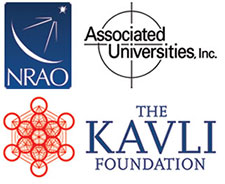
The NRAO is organizing a series of three conferences for the broader community to discuss potential U.S. futures for radio-millimeter-submillimeter science in the 2020’s and beyond. Funded by Associated Universities, Inc. (AUI) and the Kavli Foundation, the first of these meetings will take place 15-17 December 2015 in Chicago at a to-be-determined hotel near the O’Hare Airport. The Science Organizing Committee co-chairs for this meeting will be Mark Reid (CfA) and Jean Turner (UCLA).
So please save these dates (15 – 17 December 2015) and join us for this important and exciting discussion of the future of U.S. radio-millimeter-submillimeter science.
More information about this meeting will appear in the next (June) eNews, including the conference website and registration information.
Sign-up for the New IAU Radio Astronomy Commission
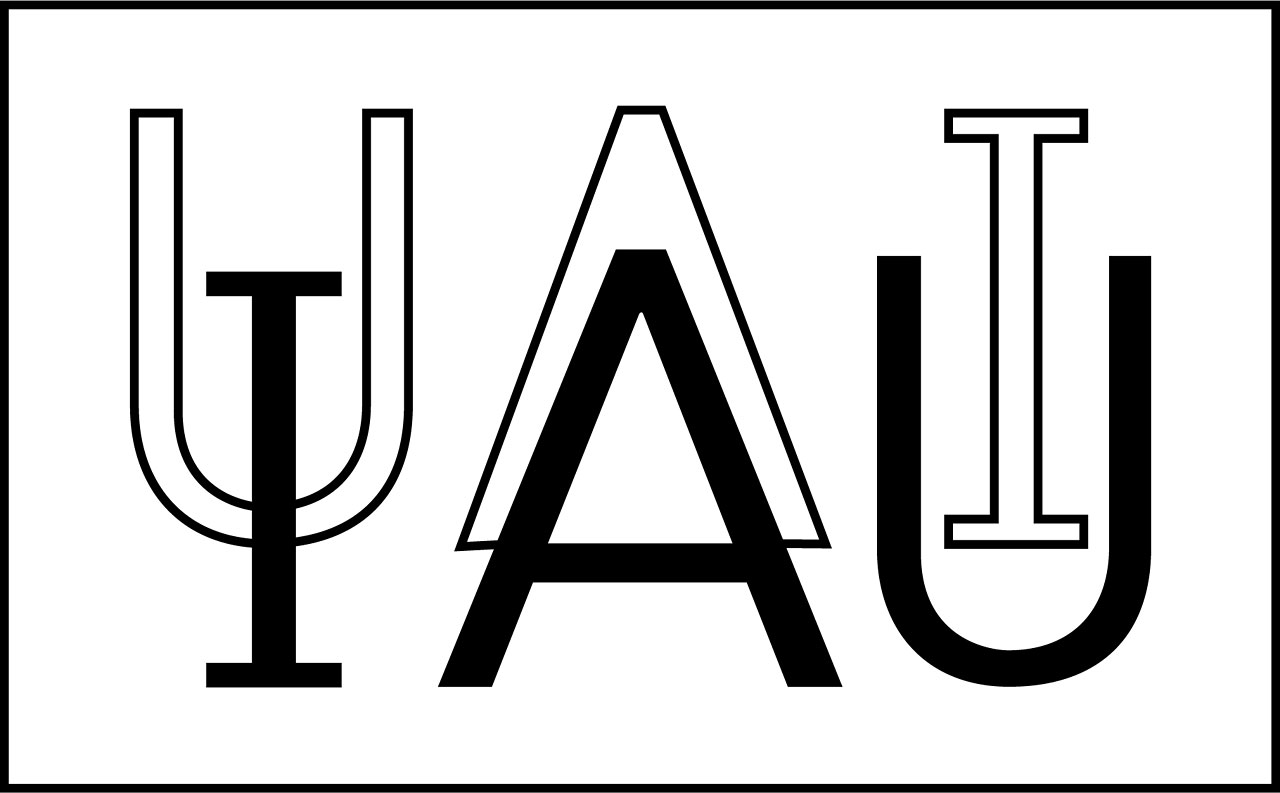
The International Astronomical Union (IAU) has announced the Commissions that will be created at the end of the 2015 IAU General Assembly in Honolulu. These new Commissions resulted from the evaluation of the full proposals that were received by the IAU in response to the Call for Proposals for Commissions issued in June 2014. The IAU Division Presidents and the Executive Committee Vice-Presidents evaluated these proposals, and the Executive Committee approved the recommended new IAU Commissions at their April 2015 in Padua, Italy.
The window for current IAU members to sign-up for up to three (3) of these new Commissions began on Thursday, 30 April 2015 and will continue through Friday, 15 May 2015.
IAU members should have received an e-mail message from IAU General Secretary Thierry Montmerle on or about Wednesday, 29 April, that describes how to sign up for the new IAU Commissions. If you did not receive or have misplaced this e-mail, please contact iauinfos@iap.fr. We encourage every interested IAU member to sign-up for and actively participate in the new Radio Astronomy Commission.
IAU General Assembly Highlights
The August 2015 IAU General Assembly in Honolulu will include a range of content and meetings relevant to radio-wavelength astronomy, including programming to inform the community regarding the recent activities of:
- IAU Division B (Facilities, Technologies, and Data Science)
- Commission 40 (Radio Astronomy) and the Scientific Committee on Frequency Allocations for Radio Astronomy and Space Science (IUCAF)
- Commission 40 – Historic Radio Astronomy Working Group, and the
- Square Kilometre Array (SKA).
Additional information on these IAU General Assembly events follows.
IAU Division B (Facilities, Technologies, and Data Science) Meeting
7 & 10 August 2015
The Division B meeting aims “ … to provide high-level science-motivated summaries of recent astronomical technology advances and to look forward to technology challenges and opportunities in the near and more distant future.” The complete program will be published soon, and is expected to include a number of radio astronomy-related talks. Additional information.
Commission 40 – Radio Astronomy
Historic Radio Astronomy Working Group Meeting
Tuesday, 5 August 2015, 10:30 – 12:30 & 16:00 – 18:00
The Historic Radio Astronomy Working Group will celebrate the 50th anniversary of the remarkable discoveries that occurred during the 1960s. Meeting agenda.
Commission 40 – Radio Astronomy / IUCAF Business Meeting
Wednesday, 6 August 2015, 08:30 – 12:30
A joint business meeting for Commission 40 (Radio Astronomy) and the Scientific Committee on Frequency Allocations for Radio Astronomy and Space Science (IUCAF) will include discussion of the IAU Commissions restructuring and the outcomes of a proposal for a new Radio Astronomy Commission. Goals and planning for this new Commission will be discussed, and planning for new Working Groups will be considered. The IUCAF Chair and members will report their activities towards the protection of the passive radio spectrum, and IUCAF membership will be considered. The meeting will provide a forum for broader discussion of radio astronomy spectrum requirements. Point-of-contact: Jessica Chapman.
Square Kilometre Array Observatory: Current Status and Science Program
Sunday, 9 August 2015, 09:00 – 17:00
Program in preparation. Point-of-contact: William Garnier
Evolutionary Map of the Universe (EMU) International Meeting
Wednesday, 12 August 2015, 10:00 – 17:00
Session 1: Australia SKA Pathfinder (ASKAP) & EMU updates
Session 2: ASKAP – EMU Science
Program in preparation.
ALMA Program News
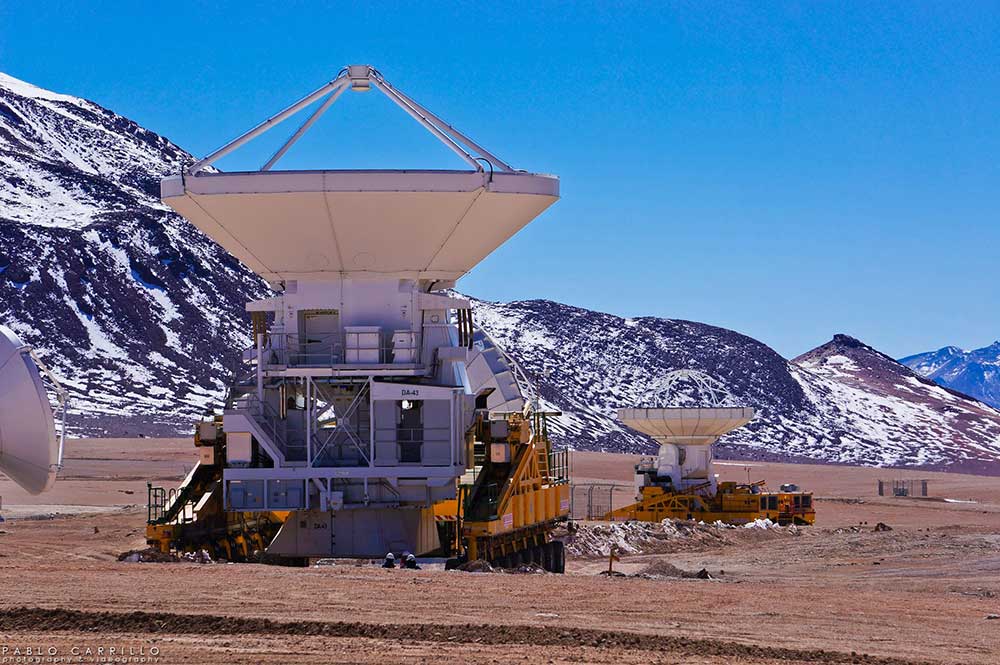
Pablo Carillo.
The two ALMA transporters, Otto and Lore, are active in the current reconfiguration of ALMA from a compact C34-1/(2) configuration into a more extended C34-3/(4) configuration in which it will observe for the remainder of May.
[click to enlarge]
ALMA Early Science observations began at the end of March 2015. The antennas were deployed in their compact configuration, characteristics of which may be examined at the ALMA status page. In mid-May, the antennas will be moved to the larger C34-3(4) configuration (maximum baselines ~500m) as described in a Science Portal article in March. The array will gradually move to more extended configurations as Cycle 2 Early Science progresses, leading to the beginning of Cycle 3 on 1 October 2015.
ALMA received 1582 unique proposals by the close of the Cycle 3 submission process on 23 April, compared to 1382 proposals in Cycle 2. A total of 9037 hours was requested for the array of 12m telescopes, a 24% increase over the 7314 hours requested in Cycle 2. The total time requested for standard observing modes was 6913 hours and for non-standard modes 2124 hours. Forty-seven countries represented by more than 1100 individual PIs and three times that many proposers (PIs and Co-Is from the total registration pool of 6428) were involved in the submitted proposals. The fractions of proposals coming from the three Executives, Chile, and outside the partnership was similiar to those received in previous cycles: 29% North America, 42% Europe, 19% East Asia, 8% Chile, and 3% Outside.
It is anticipated that about 2100 hours of 12m Array time and a similar amount of Atacama Compact Array time will be available for Cycle 3 projects and the highest-priority projects that were transferred from Cycle 2.
The Cycle 3 proposals will be sorted and sent to the referees over the course of the next weeks. The Review Panels will meet 22-26 June 2015 in Osaka, Japan with the final proposal ranking expected in August 2015.
During ALMA construction phases the construction staff, operations staff, and visitors lived in temporary container quarters at the Operations Support Facility (OSF). With the end of construction, housing needs have approached their steady-state levels. Construction of the permanent quarters, the Residencia, has begun at the OSF and will continue over the next 18 months. The Residencia has been designed to provide a pleasant on-site environment for staff and for visitors who come from more than 20 countries worldwide.
An Operations Review Meeting was hosted at the ALMA – Santiago Central Office on 28-30 April 2015. Nine members of an external Operations Review Panel appointed by the ALMA Board examined the plans for steady-state ALMA Operations. The ALMA Operations Review Panel assessed the performance of the Joint ALMA Observatory and the Regional ALMA Science Centers in facilitating efficient scientific use and optimization of the science output and impact of ALMA.
A Call for ALMA Development Studies was issued 16 March 2015 and will remain open until 12 June. Prospective proposers were asked to file a Notice of Intent by 1 May. All members of the North American ALMA Operations partnership, and the North American radio astronomy community at-large, are invited to participate in the ALMA North American Development Program.
GBT Observations of OH emission from Milky Way "Dark Gas"
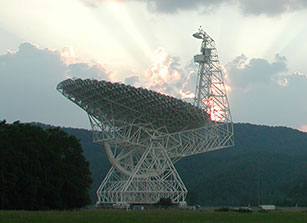
Many studies of the gas and dust in the Milky Way have suggested that there is an interstellar component not traced by neutral atomic HI, yet at the same time not easily detected by the most-studied molecular tracer, emission in the CO(1-0) line. All-sky observations with the Planck telescope indicate that such "CO-dark" gas is widespread, and potentially an important component of the interstellar medium.
Deep observations of OH with the NRAO Green Bank Telescope (GBT) have now shown that mainline OH emission can be detected in many directions lacking detectable CO(1-0) emission. A blind survey of a region of the Galactic plane around (long, lat) = (150°, +1°) found 1667 MHz OH emission in more than 75% of the directions studied. Line ratios indicate that the emission is optically thin and in LTE. Fewer than half of the OH spectral features show detectable CO counterparts at the sensitivity level of existing CO surveys, suggesting that main-line OH emission may be a promising tracer of "CO-dark" gas. This pilot study is being followed by more extensive observations that will help determine the utility of OH emission in understanding the properties and distribution of the dark component of the ISM.
Reference: Allen, R.J., Hogg, D.E., & Engelke, P.D. 2015, AJ, 149, 123
High Frequency Science with the Green Bank Telescope
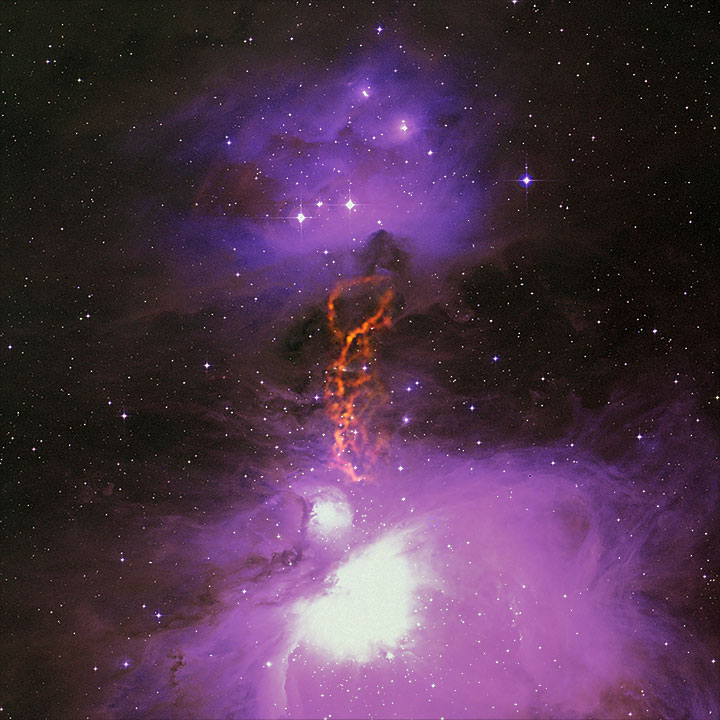
GBT measurements of 3mm dust continuum emission from Orion Molecular Cloud 2/3 (orange) on an image of the Orion nebula (Schnee et al. 2014, MNRAS, 444, 2303).
[click to enlarge]
Science with the NRAO Green Bank Telescope (GBT) at its high frequencies (18 - 116 GHz) is flourishing, and new multi-pixel cameras for continuum and spectroscopy are being commissioned this year.
We are organizing a workshop at NRAO – Green Bank 21-23 September 2015 that will survey the range of high-frequency science made possible with the existing and new GBT instrumentation. The goal of the workshop is to come to an understanding of community interest in the GBT for high-frequency observations, and the role of the GBT in research, instrumentation development, and hands-on training for the scientific community in the era of the Atacama Large Millimeter/submillimeter Array.
The workshop will be held at the NRAO – Green Bank Observatory in Green Bank, WV starting at 9:00 EDT Monday, 21 September and ending with lunch on Wednesday, 23 September. Logistical considerations limit the number of participants to about 50 persons.
Please visit the workshop website for further information and pre-registration.
Scientific Organizing Committee
F.J. Lockman, NRAO – Green Bank (Chair)
John Bally, University of Colorado
Sarah Church, Stanford
Mark Devlin, University of Pennsylvania
Shep Doeleman, Haystack Observatory – MIT
Dave Frayer, NRAO – Green Bank
Alyssa Goodman, Harvard
Andy Harris, University of Maryland
Adam Leroy, Ohio State
Brian Mason,
NRAO
Karl Menten, Max Planck Institute for Radio Astronomy
Richard Prestage, NRAO – Green Bank
Craig Sarazin, University of Virginia
Yancy Shirley, University of Arizona
2015 Jansky Lectureship Awarded to Nick Scoville

Nick Scoville
[click to enlarge]
Associated Universities, Inc. (AUI), and the NRAO have awarded the 2015 Karl G. Jansky Lectureship to Dr. Nick Z. Scoville of the California Institute of Technology (Caltech). The Jansky Lectureship is an honor established by the trustees of AUI to recognize outstanding contributions to the advancement of radio astronomy.
Scoville leads the Cosmic Evolution Survey (COSMOS), a project that uses data from virtually every large space- and ground-based telescope, including the NRAO Very Large Array, to study the large-scale structure of the Universe and the evolution of galaxies. Begun in 2004 with a large allocation of observing time on the Hubble Space Telescope, COSMOS now has detected more than a million galaxies back to the first billion years of the Universe. Scoville is currently using ALMA to investigate the evolution of star formation in the early Universe and colliding starburst galaxies.
A professor at Caltech since 1983, Scoville received his Ph.D. from Columbia University in 1972. He was a pioneer in millimeter-wave astronomy and is a leading expert in studies of galaxy evolution, the nature of the dense interstellar molecular gas in galaxies, and in the process of star formation, both in the nearby and in the distant, early Universe. He is a past director of Caltech's Owens Valley Radio Observatory, and has served on numerous national committees. Author of more than 600 publications in both observational and theoretical astrophysics, Scoville's previous awards include a Guggenheim Fellowship, the Aaronson Award of the University of Arizona, and serving as Bishop Lecturer at Columbia University .
The dates for the Dr. Scoville’s 2015 Jansky Lectures will be available soon and will be published in eNews and at the NRAO science and public websites.
Amazon – SKA Cloud Computing Call for Proposals

Amazon Web Services and the Square Kilometre Array (SKA) Organisation have issued a joint Call for Proposals to use Amazon cloud computing resources for radio astronomy data reduction, or for tools and techniques development. This Call is open to the broad radio astronomy community, including NRAO observers and staff. Additional information on this Call is available at the SKA Organisation website, including links to other resources and mailing lists.
Independent of this Amazon-SKA Call, James Robnett (NRAO Scientific Information Services Architect), in collaboration with ICRAR and following the pioneering work of the Cosmos HI Large Extragalactic Survey (CHILES) project, has initiated work to make the Common Astronomy Software Applications (CASA) package and the ALMA / VLA pipelines relatively easy to use on the Amazon cloud computing infrastructure. If you are granted time under this Call, Robnett will be able to assist you in using the infrastructure he is developing. We believe that this could be an attractive option for people who have heavily scripted, computing-resource-limited ALMA and/or VLA data reductions. If you have any questions about the potential suitability of a project, feel free to contact James Robnett.
NRAO Newsletter Index
An NRAO Newsletter index is available for download and can also be accessed via the navigation that accompanies the Table of Contents in the left column of each NRAO eNews issue, beginning with this issue. This index lists the content that has appeared in each issue of the NRAO Newsletter from Issue #113, published in October 2007, through the current issue of the NRAO eNews. The Newsletter index lists the title, first author, keywords, and the relevant NRAO facilities that are mentioned in each article.
Recent Media Releases
3D Visualization Text Published
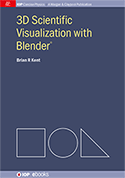
A new book titled “3D Scientific Visualization with Blender” by NRAO Associate Scientist Brian R. Kent has recently been published by IOP / Morgan & Claypool Publishers and is available in print and eBook formats.
Blender is an open source visualization suite widely used in the entertainment and gaming industries; Kent’s book is a practical introduction to Blender. Using step-by-step guided tutorials, “3D Scientific Visualization with Blender” provides a detailed understanding of key aspects of three-dimensional rendering, animation, and modeling that pertain to the sciences.
Additional information is available at these book and companion websites.
Career Opportunities
Postdoctoral Fellowship: The NRAO in Santiago, Chile is now accepting applications for a Postdoctoral Fellow to join the Atacama Large Millimeter/submillimeter Array (ALMA) at this exciting period during which the array is ramping up to its full operational potential. ALMA Postdoctoral Fellows are appointed for a period of three years and spend at least 50% of their time dedicated to their personal research.
Visiting Support Scientific Associate: The NRAO in Charlottesville, VA is now accepting applications for a Visiting Support Scientific Associate position. The North American ALMA Science Center (NAASC) is offering one or more short-term (3-6 month) temporary appointments to scientists who are interested in participating in the reduction and imaging of ALMA data. The primary goal of the position(s) will be to provide assistance to Observatory users by reducing ALMA data and assessing data quality. There will also be opportunities for independent research.
Data Analyst/Scientific Associates (Multiple Positions Available): The NRAO in Charlottesville, VA is now accepting applications for Data Analyst / Scientific Associates. The primary goal of the Data Analysts will be to provide assistance to Observatory users by reducing data and assessing data quality, operating a data reduction pipeline, answering questions in the online helpdesk system, assisting with observing script preparation, testing Observatory software, and contributing to the data delivery process.
Software Engineer (Open Rank): The NRAO in Socorro, NM is now accepting applications for a Software Engineer to join the Science Support and Archive (SSA) development team. The duties of the SSA members include the maintenance and necessary upgrades of the existing software, as well as developing new products to meet the challenges posed by the new observing paradigms necessary for the Observatory to remain at the cutting-edge of science and technology.
Software Engineer II (1521): The NRAO in Socorro, NM is now accepting applications for a Software Engineer II position in the ALMA control software group. The ALMA control software team designs, implements, and maintains online software used to operate ALMA. This includes the software for automatically selecting what to observe (scheduling software), software that decomposes the high-level parameters to the commands sent to each piece of hardware (control software), and software that collects the data and processes it down to a manageable volume (correlator software). This requires close interaction with a diverse range of people on multiple continents.
Software Engineer II (1601): The NRAO in Socorro, NM is now accepting applications for a Software Engineer II position concerned primarily with updating and maintaining the software for the observation-planning phase for the Data Management & Software (DMS) development team. As part of the DMS team, the successful candidate will develop and maintain software used by the astronomy community for proposing, planning, scheduling, and analyzing observations performed with NRAO telescopes.
Assistant Scientist: The NRAO in Socorro, NM is now accepting applications for an Assistant Scientist position. The scientist recruited for this position is expected to facilitate and enable cutting-edge science by community members and work to enhance the observing capabilities for the VLA. The ideal candidate will contribute to the overall NRAO mission and must be able to demonstrate success working within a collaborative environment that promotes motivation, leadership, and team building.
For additional information on these openings and other NRAO career opportunities, please visit the NRAO – Career Opportunities web pages.
From the Archives
Ellen Bouton

[click to enlarge]
About this month's photograph: Fifty years ago, on 23 May 1965, the first observations were made with the not yet completed 140-foot telescope in Green Bank, five months before the telescope's official dedication. NRAO – Green Bank staff member Sebastian von Hoerner observed a lunar occultation of a radio source at 234, 256, and 405 MHz. Speaking about those first observations at the 140-foot telescope’s 30th birthday symposium, von Hoerner said, "In May 1965, a good occultation was just coming up. I wanted to grab it, and I did." But the telescope was barely ready.
In this photo, taken on 20 May 1965, just three days before the occultation, two (unidentified) staff members are installing the receiver system in the still empty focal ring. They are standing on a lift rather than in the service tower that was not yet completed. Although Associate Director for Engineering Services Hein Hvatum worried that the telescope would not be ready for von Hoerner's observations, everything was in working order in time.
Over the next months, the "hungry" Green Bank scientific staff competed for observing time while still putting the finishing touches on the telescope, including spending cold nights on the dish measuring and adjusting the surface. A June 1965 Observer article thanked staff who devoted " … time, energy, life, liberty, and pursuit of accomplishment in order that this instrument may bring us secrets from the universe." By the 13 October 1965 dedication, the new 140-ft telescope had already made a number of important discoveries, including the dramatic 9 July detection by Bertil Hoglund and Peter Mezger of radio recombination lines, which ushered in a whole new field of radio astronomy research.
From the Archives is an ongoing series illustrating NRAO and U.S. radio astronomy history via images selected from our collections of individuals' and institutional papers. If readers have images they believe would be of interest to the Archives, please contact Ellen Bouton.

